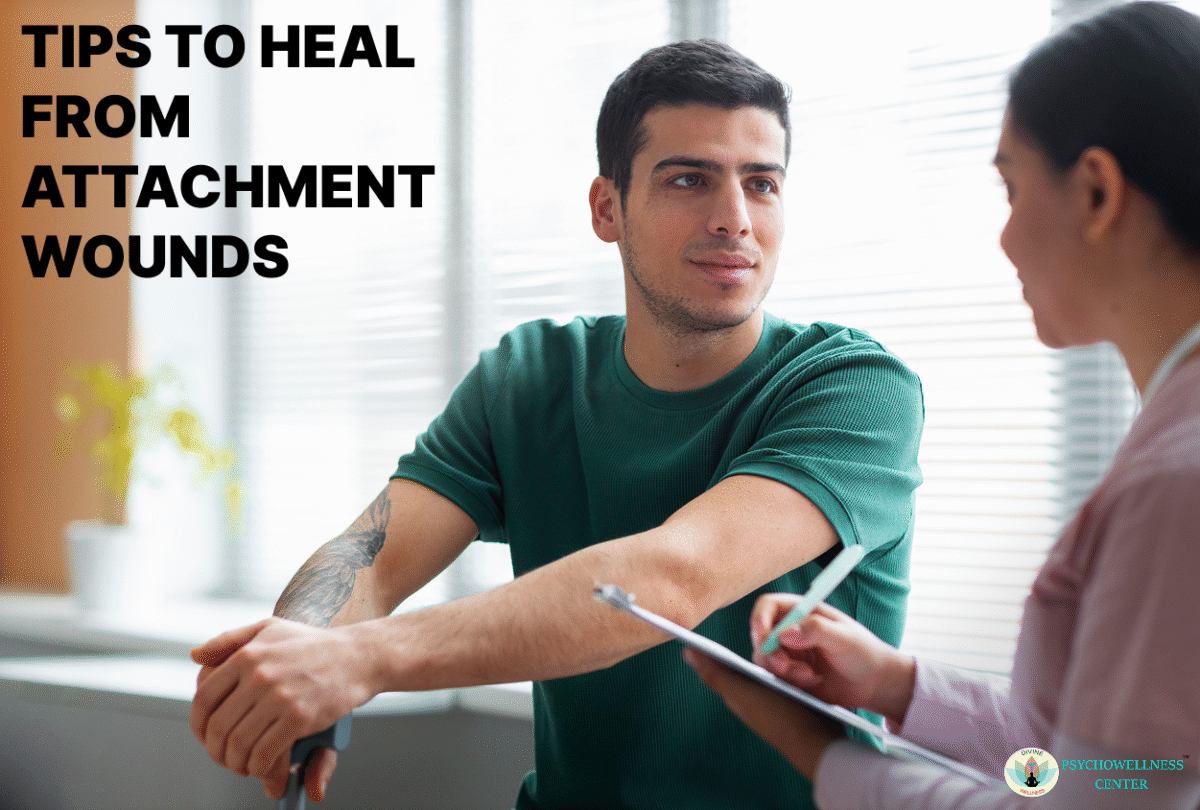Attachment wounds, often rooted in early relational experiences, can significantly influence emotional well-being, relationships, and mental health. Individuals with unresolved attachment injuries may experience depression and anxiety, low self-esteem, emotional dysregulation, and chronic burnout. These challenges may manifest in difficulty forming healthy connections, fear of intimacy, or over-dependence on others for validation. This blog offers practical, evidence-based strategies for healing attachment wounds, including the use of cognitive-behavioural therapy (CBT), mindfulness, and support from an online therapist.
Attachment theory, pioneered by Bowlby (1969), asserts that the bonds formed in early childhood shape emotional regulation, interpersonal relationships, and self-image. When these bonds are disrupted by neglect, abuse, or inconsistent caregiving, attachment wounds may develop. Such wounds are not only psychological scars but also ongoing sources of emotional vulnerability, often manifesting in depression and anxiety, persistent burnout, and diminished self-esteem. The good news is that healing is possible with the right therapeutic approaches, self-awareness, and consistent support from trained professionals.
Understanding Attachment Wounds and Their Impact
Attachment wounds stem from relational trauma instances where emotional needs were repeatedly unmet or met with fear, rejection, or inconsistency. Over time, these experiences influence core beliefs about safety, trust, and worthiness (Siegel, 2012).
Common effects include:
- Depression and Anxiety: Unresolved emotional injuries can create persistent feelings of sadness, fear, and hypervigilance. These symptoms often intensify during relationship stress.
- Burnout: Chronic relational stress can deplete emotional and physical energy, making it harder to engage in both personal and professional life.
- Low Self-Esteem: Early invalidation fosters internalised beliefs of inadequacy, leading individuals to question their worth in relationships and achievements.
- Relational Difficulties: People may develop avoidant or anxious behaviours, struggle with healthy boundaries, or experience conflict cycles in relationships.
Tip 1: Recognise and Validate Your Emotional Experience
Healing begins with acknowledging your pain without judgment. Many people minimise their past wounds because they fear being seen as weak or overly sensitive. However, emotional invalidation whether self-imposed or from others reinforces the wound.
Practical steps:
- Journaling: Document feelings and triggers to increase emotional awareness.
- Mindfulness meditation: Practice observing emotions without trying to suppress or control them.
- Self-compassion exercises: Speak to yourself as you would to a close friend facing similar struggles.
Recognising that your emotional reactions are valid opens the door to self-acceptance and resilience.
Tip 2: Engage in Trauma-Informed Therapy
Working with a mental health professional trained in attachment and trauma can be transformative. Platforms such as TalktoAngel and PsychoWellnessCenter provide access to licensed online therapists specialising in attachment issues.
Why CBT helps:
Cognitive-behavioural therapy addresses maladaptive thought patterns, helping individuals reframe beliefs like “I am unlovable” or “People will always leave me.” Trauma-focused CBT (TF-CBT) combines cognitive restructuring with gradual exposure to distressing memories, allowing emotional integration without re-traumatisation.
Tip 3: Build Emotional Regulation Skills
Attachment wounds often make emotions feel overwhelming. Techniques for emotional regulation can lessen anxiety and stop impulsive behaviors.
- Breathing exercises: Techniques such as diaphragmatic breathing help calm the nervous system.
- Grounding exercises: Using sensory cues (touch, sight, smell) to stay present during distress.
- Body-based practices: Yoga or progressive muscle relaxation can help process trauma stored in the body.
Tip 4: Rebuild Self-Esteem Through Consistent Actions
Low self-esteem from attachment injuries can perpetuate cycles of unhealthy relationships and self-sabotage. Instead of waiting to “feel” confident, build esteem through small, consistent actions:
- Set and maintain personal boundaries.
- Pursue hobbies and skills that reinforce your competence.
- Celebrate small wins to shift focus from perceived failures to progress.
Tip 5: Cultivate Secure Relationships
Healthy, supportive relationships accelerate healing. This may mean reassessing current connections and limiting exposure to toxic or emotionally unavailable individuals.
- Seek out friends or partners who respect your boundaries.
- Practice open communication to express needs and feelings clearly.
- Engage in group therapy or support circles where trust can be built gradually.
Tip 6: Practice Inner Child Healing
Many attachment wounds originate in childhood. Inner child work helps you connect with that younger self, offer compassion, and meet unmet needs.
- Use visualisation to imagine comforting your younger self.
- Write letters to your inner child expressing safety and acceptance.
- Engage in playful, creative activities that were denied or discouraged in childhood.
Tip 7: Establish Consistency and Predictability
For those with insecure attachment styles, unpredictability can trigger anxiety. Create stability through routines:
- Maintain regular sleep and meal schedules to support emotional balance.
- Develop consistent communication patterns with close connections.
- Set realistic, achievable goals to foster a sense of control.
Conclusion
Attachment wounds may feel like lifelong burdens, but with intentional effort, professional support, and self-compassion, they can become sources of growth and resilience. Approaches such as CBT, mindfulness, and emotional regulation training can significantly reduce the symptoms of depression, anxiety, burnout, and low self-esteem. For those seeking guidance, professional counselling and therapy can be transformative. The Psychowellness Centre, with locations in Janakpuri and Dwarka Sector-17, offers in-person sessions with compassionate experts including some of the best psychologists near me who specialise in healing emotional wounds and fostering secure attachments. For those who prefer online support, TalktoAngel provides confidential virtual counselling and therapy, making expert care accessible from the comfort of your home. The journey begins with one step: reaching out for the support you need.
Contribution: Dr. R.K. Suri, a clinical psychologist, and Ms. Nancy Singh, a counselling psychologist
This blog was posted on 6 September 2025
References
Bowlby, J. (1969). Attachment and loss: Vol. 1. Attachment. Basic Books. https://doi.org/10.4324/9780429482410
Siegel, D. J. (2012). The developing mind: How relationships and the brain interact to shape who we are (2nd ed.). Guilford Press. https://www.guilford.com/books/The-Developing-Mind/Daniel-J-Siegel/9781462520671
Shorey, R. C., & Snyder, C. R. (2006). The role of adult attachment styles in depression and anxiety: Testing a multiple mediator model. Journal of Social and Clinical Psychology, 25(9), 975–1000. https://doi.org/10.1521/jscp.2006.25.9.975
TalktoAngel. (n.d.). Online therapy with the best psychologists & counselors. TalktoAngel. https://www.talktoangel.com
https://www.psychowellnesscenter.com/Blog/breaking-the-insecure-attachment-pattern/
https://www.psychowellnesscenter.com/Blog/living-with-reactive-attachment-disorder-as-an-adult/
https://www.psychowellnesscenter.com/Blog/use-of-self-resonance-in-trauma-healing/
https://www.psychowellnesscenter.com/Blog/how-to-deal-with-daddy-issues/
https://www.talktoangel.com/blog/how-attachment-trauma-affects-adult-conflict-patterns
https://www.talktoangel.com/blog/use-of-art-therapy-to-heal-invisible-wounds
https://www.talktoangel.com/blog/ways-to-deal-with-baggage-and-core-wounds-in-a-relationship

